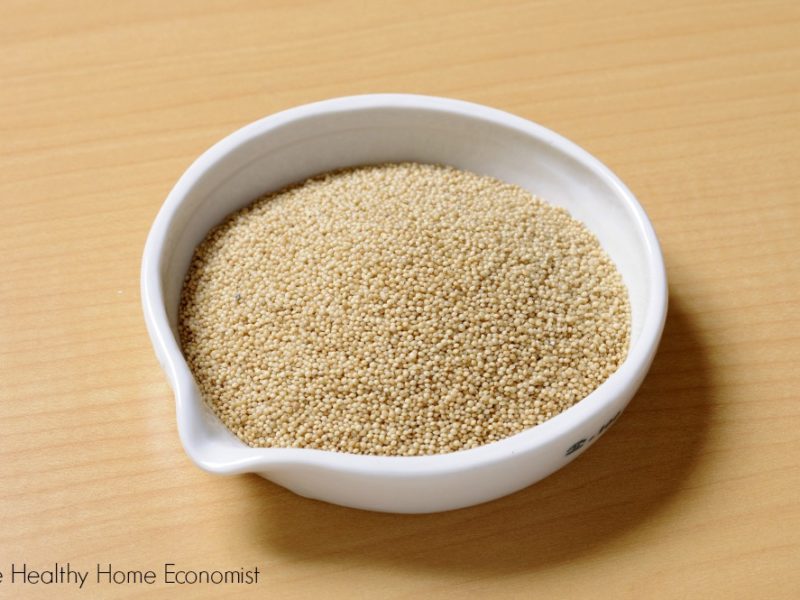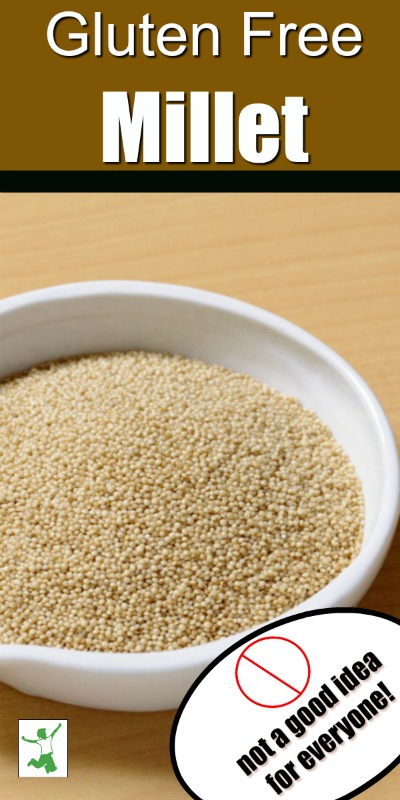Examination of why millet should optimally be eaten in moderation as a gluten-free whole grain in order to avoid disrupting hormone health.

Gluten allergies are clearly on the increase in our modern society. It seems like practically every other person I know these days has some sort of digestive issue that avoiding gluten would probably improve.
At the top of the list of gluten-containing foods is wheat. It is the indisputable, primary staple of the Western diet. Wheat is also the very foundation of the controversial USDA Food Pyramid.
Given how important bread and other wheat-based carbohydrates are to our society’s basic food requirements, it’s no wonder that folks seek a quick and easy substitute for wheat bread and wheat-based snacks when a gluten allergy or Celiac disease has been diagnosed.
Millet: Ancient Gluten-free Whole Grain
Enter millet. This ancient grain was cultivated in East Asia as far back as 10,000 years ago, according to archaeologists. Surprisingly, the cultivation of millet in prehistoric times was more prevalent than even rice, particularly in what is now China and the Korean peninsula.
Millet’s resistance to drought is perhaps the reason for its popularity in ancient times and its spread to Europe by 5000 B.C.
Despite the 5000 years cultivating this whole grain as a staple food, millet porridge is considered a traditional food in Russia as well as China. Use of millet is also widespread in Africa, like gluten-free teff, likely due to the drought-prone climate.
Millet Bread: Logical Substitute for Wheat
The protein structure of millet is quite similar to wheat. The one glaring exception is that millet is a gluten-free grain. Wheat contains copious amounts of this hard to digest plant protein.
When plain millet flour is used for baking bread (as opposed to homemade gluten-free flour or a healthy gluten-free flour mix from the store), the resulting loaf is light, white, and quite similar in texture to wheat bread. As a result, people who wish to avoid gluten tend to immediately gravitate to millet bread as the most logical and palatable substitute.
Millet bread is extremely popular in health food stores. Sami’s Bakery and Deland Bakery are two local bakeries that sell an absolute ton of millet bread to these stores around my local metro area.
I recently corresponded with a person up the East Coast of the USA who was consuming a lot of the millet/flax chips as an alternative to wheat-based snacks and had no idea of the potential health risks from consuming so much millet.
It was this discussion that led me to write this blog and warn folks about the dangers of consuming too much millet!
Potent Goitrogens
While millet does not contain gluten, it does contain goitrogens. These are substances that suppress thyroid activity and can lead to goiter. This condition involves enlargement of this very important gland which resides in the throat. Low iodine intake can also lead to goiter for those who rely on millet as a staple according to the Journal of Endocrinology and Metabolism.
Hypothyroidism is a serious and sometimes debilitating condition. It accompanies a weak or enlarged thyroid such as what occurs with goiter. Depression, difficulty losing weight, loss of hair, cold hands/feet, and fatigue are common hypothyroid symptoms. By some estimates, hypothyroidism is at epidemic proportions in Western society. (1)
Goitrogens in foods that contain them are usually reduced by cooking such as cruciferous vegetables like broccoli. However, cooking actually increases the goitrogenic effect of millet! Incidentally, the same effect occurs when fermenting soy.
Therefore, when folks begin eating large amounts of millet bread with a wholesale switch over from wheat, the thyroid suppressing effects of this simple dietary change can be profound. Injuring the thyroid can have a cascade effect on other glands as well. For example, those suffering from adrenal fatigue many times have thyroid issues as well.
Moderation is Critical
Protect your thyroid at all costs! It is a real challenge to unwind the effects of hypothyroidism once this vital gland is weakened or enlarged. Don’t take any chances with your thyroid health by consuming large amounts of millet bread or millet based snacks.
If gluten and/or wheat is a problem, then simply reduce bread consumption. Alternatively, use another grain that is both gluten-free and non-goitrogenic such as rice, oats or teff. Be sure to get quality, though, as rice is frequently high in arsenic.
Alternatively, try using grain-like gluten-free foods such as highly nutritious buckwheat, amaranth, or the starchy tuber cassava. They are excellent for baking too!
Millet bread consumption is fine in moderation if your thyroid is healthy – just don’t overdo it!
Given how difficult it is in modern society to maintain thyroid and overall glandular health, taking a chance by eating a lot of millet bread is a risky proposition indeed.
Traditional peoples did not have the constant stresses and strains on their glands like modern people do.
For example, they did not have to contend with pollution of their food, water, air and overall environment.
Therefore, we must be overprotective of our thyroid health. This includes avoiding regular consumption of foods that might impair it in any way.

Millet Alternatives That Preserve Thyroid Function
If you have thyroid issues and need alternatives to millet, here is a list of the healthiest options to consider.
- Einkorn Benefits (contains “good gluten“)
- Teff Benefits
- Yuca Root Benefits
- Arrowroot Benefits
- Wild Rice Benefits
- Farro (great if only modern wheat is the problem)








This question is directed to Pramod Rawat.
Hello. I have read others warning against millet. As evidence, the writers claimed that there are higher rates of goiter and other illnesses in India and throughout Africa were millet is a staple food. I suspected that even if the rates are higher in these places than in others that there are probably other factors the writers did not eliminate. For one thing, kale is all the rage in the U.S. but I have read that it , like other greens, contains goitrogens . I doubt that the large number of instances of goiter in the western hemisphere may be attributed to increased kale consumption so it must take a lot of kale to cause problems. The writers did not convince me that millet would differ radically from kale.( I think the writers were actually just suggesting cultural inferiority of the millet eaters relative to paleo eaters so they may not have had accurate information) If you live in India, will you tell me about how much a typical resident of the area you mentioned consumes in millet over the course of a week? Also, how frequently do you see people with goiters?( according to your own personal statistics of course) Thank you.
Let’s be clear .. what do we mean by millets ? There are so many varieties of millets. Probably, you are referring to pearl millet. We grew up eating millets (Finger and Barnyard) daily. Its part of our culture. People are aware of health benefits of millets over Wheat/Rice diet. There is renewed focus on millets due to diabetes/sugar/obesity/cancer pandemic …. Even with pearl millet … millions of people in Desert state of India (Rajasthan) consumer Pearl Millet daily without having any goiter related problems.
What about feeding millet to babies as a porridge? I have a 4 month that I will be starting to feed some cereal from an organic European product that has minimal ingredients and have two choices, rice flakes or millet. I was thinking millet would be best because is gluten free and easily digestible and has some health benefits but after reading this article not so sure. Any advise if I should reconsider or just use in moderation?
Cereal grains are totally inappropriate for babies that young! https://www.thehealthyhomeeconomist.com/right-way-to-feed-babies/
Love your thought! And, I got it!
And then the other concern is lectins in the diet. My physician, an integrative MD, recently put me on low lectin diet, as prescribed by Dr. Steven Gundrey. The diet does allow millet and sorghum, but no other types of grains.
Makes sense. I just had a gluten dree meal made with Millet (after being gluten-free for 2 weeks). I got so Fatigued!!! for a couple days. I’ll stick with 100% Grain-FREE diet. I felt better & even gave me energy to exercise again & reused my joint pain.
“In order to get rid of a goiter, a person needs to address the autoimmune thyroid disease, not remove goitrogens from their diet. Here is a list of common goitrogenic foods:
-Broccoli
-Brussels sprouts
-Cabbage
-Cauliflower
-Collard greens
-Flax seed
-Kale
-Mustard greens
-Pears
-Peaches
-Pine nuts
-Peanuts
-Radishes
-Rutabega
-Soy
-Spinach
-Strawberries
-Sweet potatoes
-Turnips”
Some of these foods are more goitrogenic than others. Raw broccoli and soy, for example, are very goitrogenic and a person with autoimmune thyroid disease very much needs to remove them from the diet while healing this condition!
Millet is in fact a cereal grain that comes from a grass and also a seed, as it wheat. I’m not sure where this myth originated, but unless we throw out our current definitions, millet is still a grain.
Sounds like people in the West should stay away from fluoride and not millet.
You are absolutely correct! Sugar is destroying the human body.